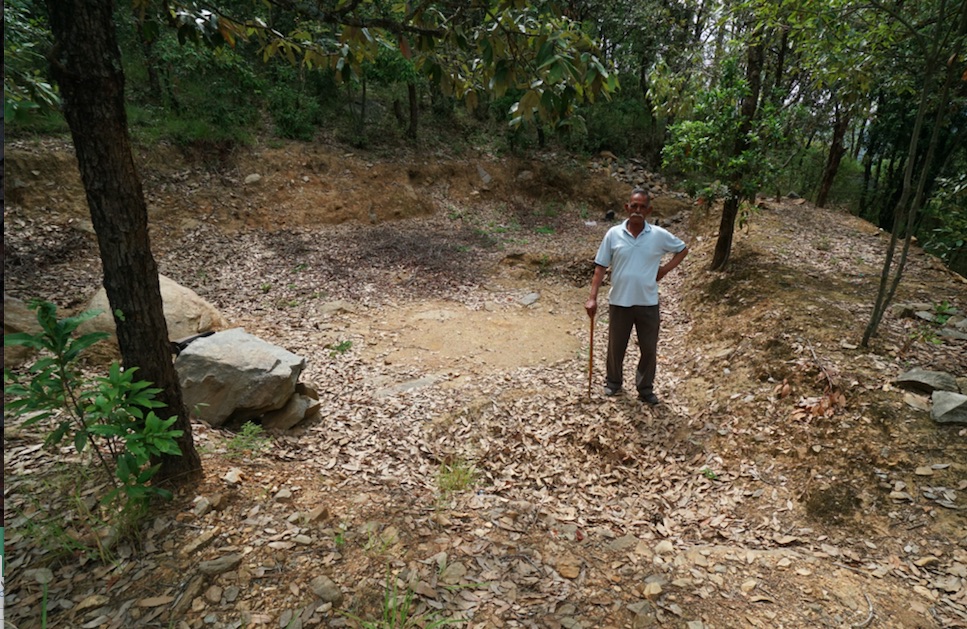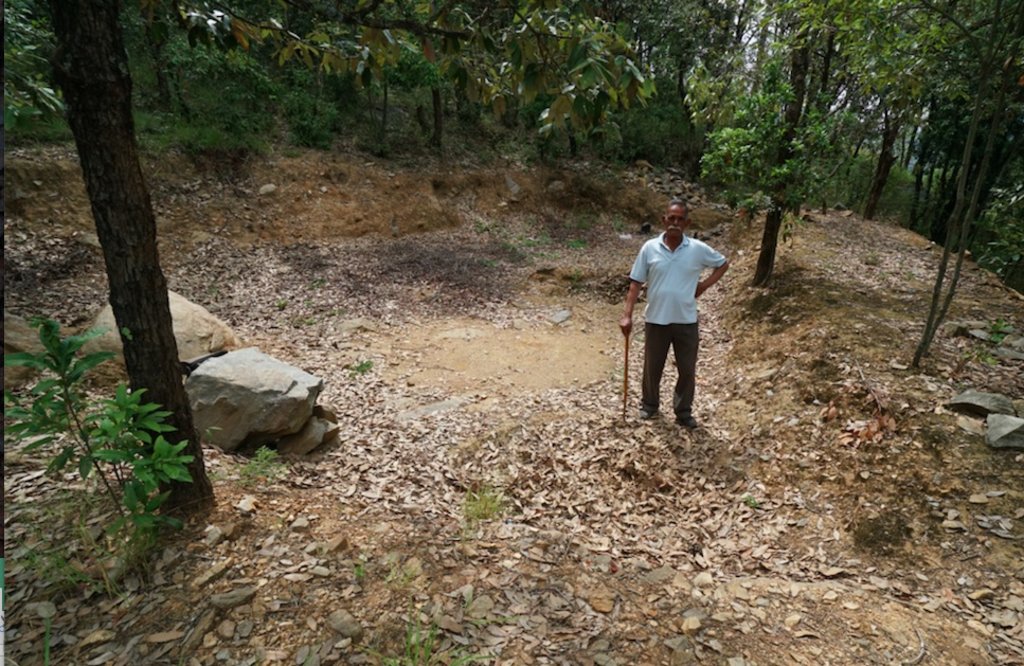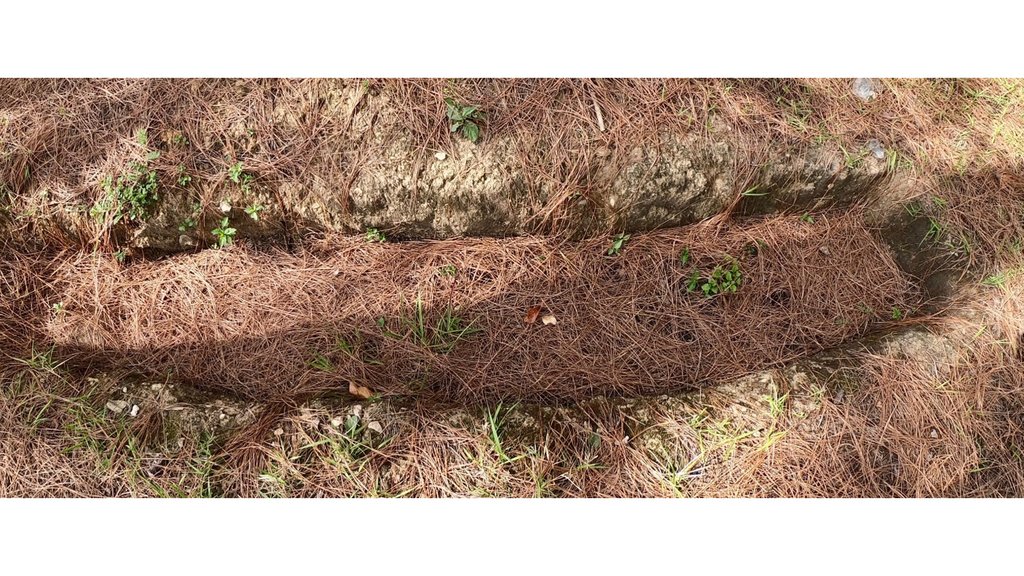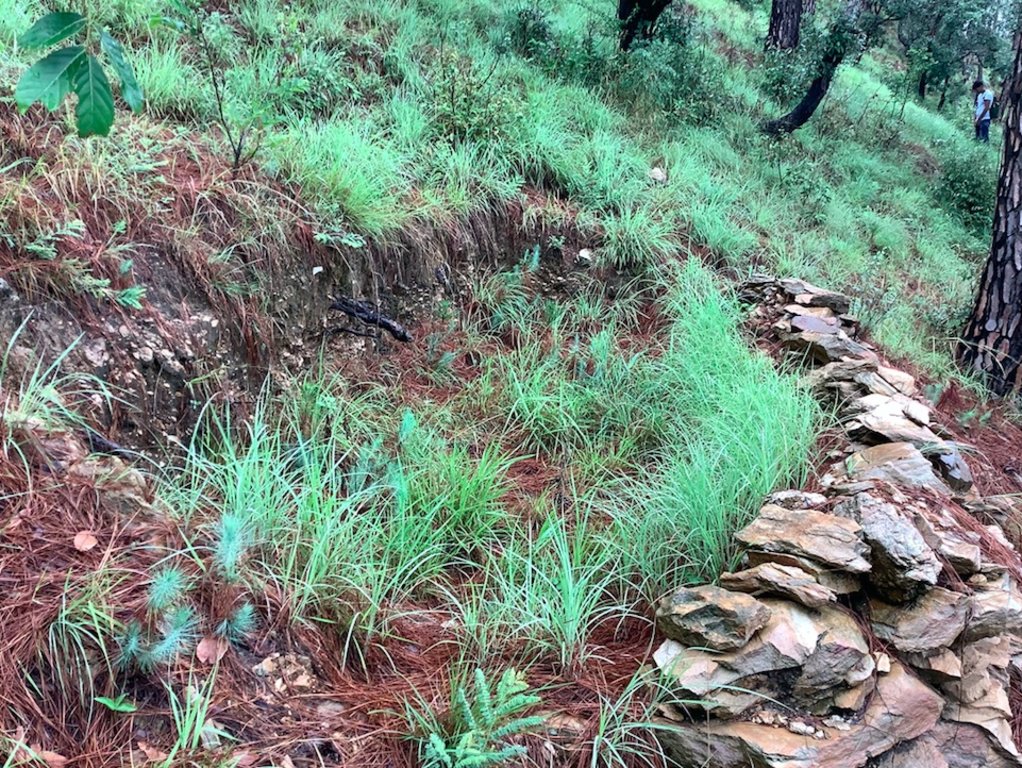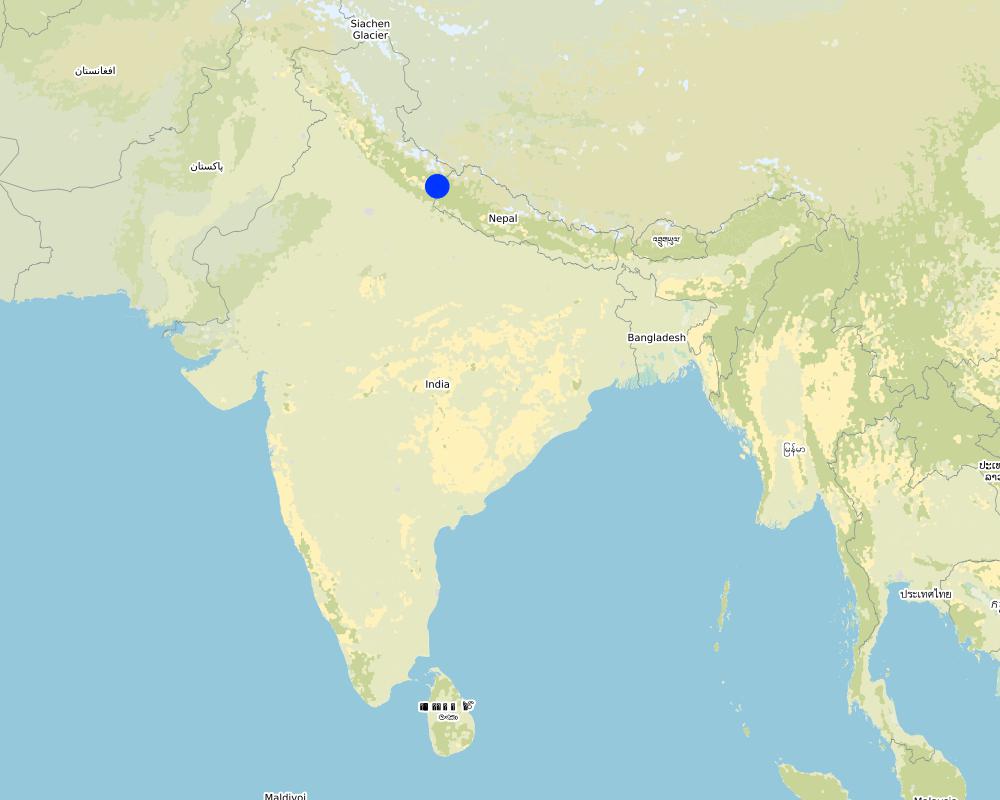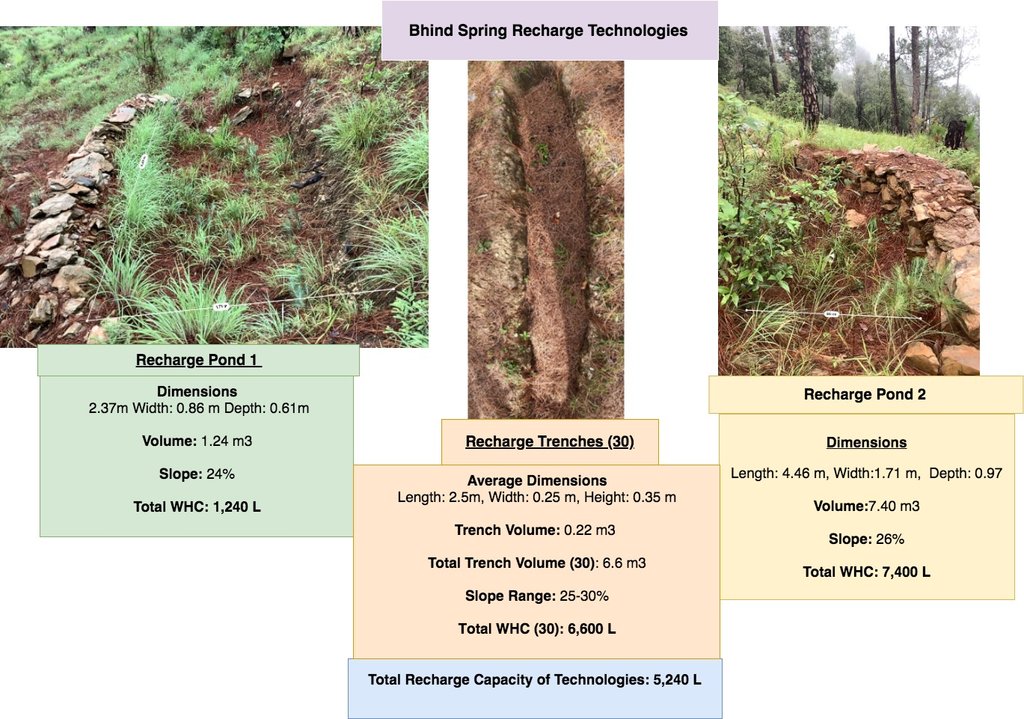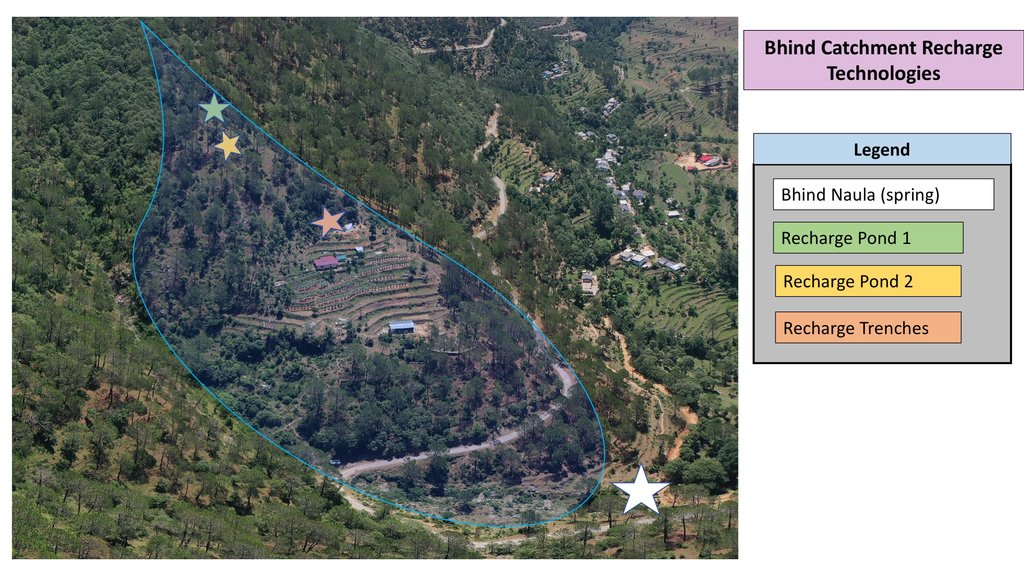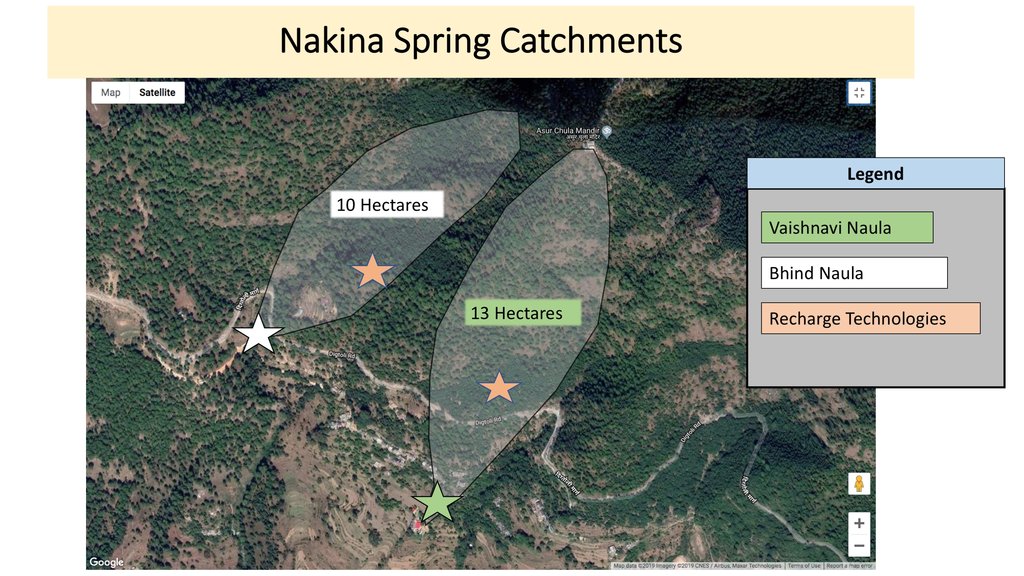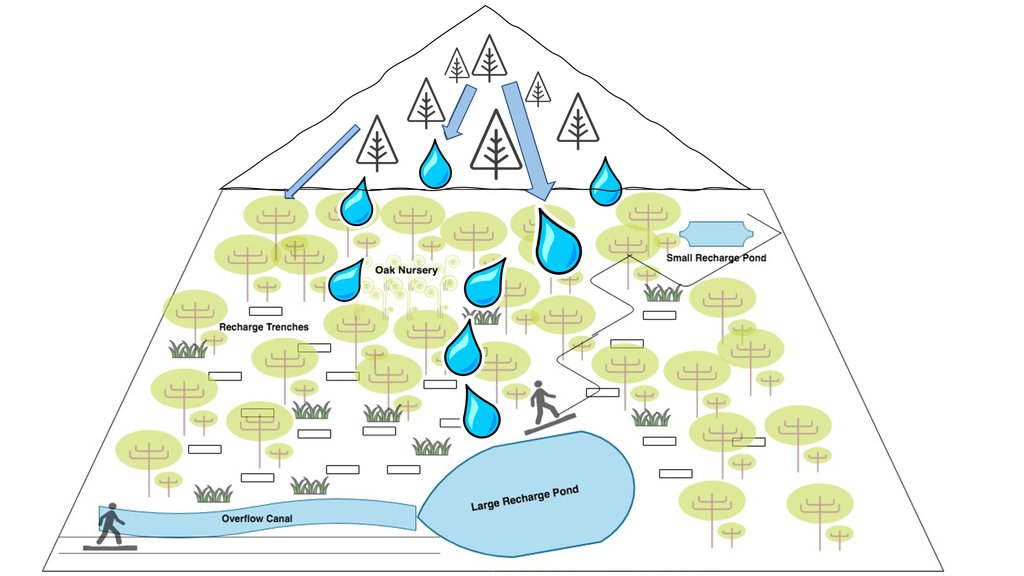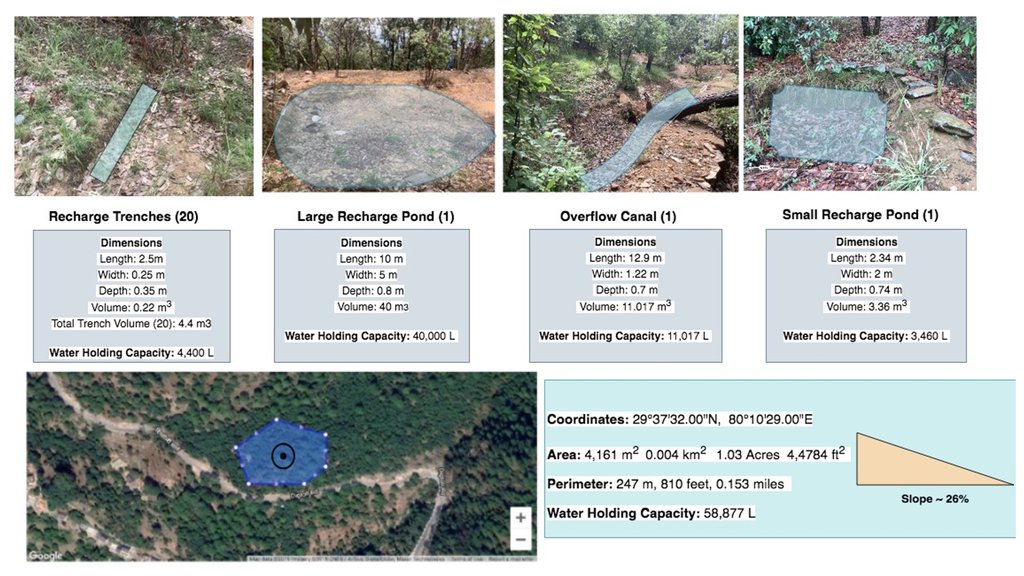Recharge Ponds and Recharge Trenches [Índia]
- Criação:
- Atualização:
- Compilador/a: Jaclyn Bandy
- Editor: –
- Revisores: Hanspeter Liniger, Rima Mekdaschi Studer
Chaal or Khals (recharge pond) and Khanti (recharge trenches)
technologies_5193 - Índia
Veja as seções
Expandir tudo Recolher tudo1. Informação geral
1.2 Detalhes do contato das pessoas capacitadas e instituições envolvidas na avaliação e documentação da tecnologia
Pessoa(s) capacitada(s)
usuário de terra:
Joshi Jagdamba Prashad
Naikina Forest Head Council (Gram Panchayat)
Índia
Nome do projeto que facilitou a documentação/avaliação da Tecnologia (se relevante)
Onsite and Offsite Benefits of SLMNome da(s) instituição(ões) que facilitou(ram) a documentação/ avaliação da Tecnologia (se relevante)
ICIMOD International Centre for Integrated Mountain Development (ICIMOD) - NepalNome da(s) instituição(ões) que facilitou(ram) a documentação/ avaliação da Tecnologia (se relevante)
G.B. Pant Institute of Himalayan Einvironment & Development (G.B. Pant Institute of Himalayan Einvironment & Development) - Índia1.3 Condições em relação ao uso da informação documentada através de WOCAT
O/a compilador/a e a(s) pessoa(s) capacitada(s) aceitam as condições relativas ao uso de dados documentados através da WOCAT:
Sim
1.4 Declaração de sustentabilidade da tecnologia descrita
A tecnologia descrita aqui é problemática em relação a degradação da terra de forma que não pode ser declarada uma tecnologia de gestão sustentável de terra?
Não
Comentários:
Like any tool, one needs to use and apply it appropriately. Land users and SLM specialists have admitted that these technologies can be ineffective depending on number, design and site selection for implementation. Recharge ponds and trenches could potentially cause soil disturbance and subsequent land degradation if such measures are not carefully considered by the users.
1.5 Referência ao(s) questionário(s) sobre abordagens GST (documentado(s) usando WOCAT)
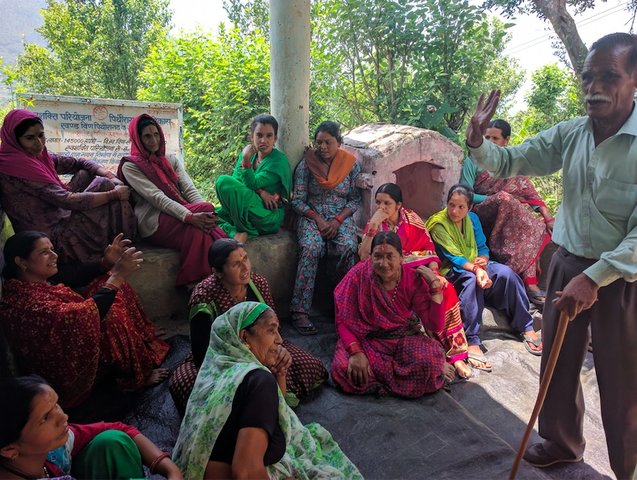
Community Forest Management in the Nakina Van Panchayat [Índia]
Van Panchayats or village forest councils are a impressive example of grassroots community management of natural resources, where a specific administrative unit is locally elected by community members who are responsible for the management of activities related to the forest.
- Compilador/a: Jaclyn Bandy

Naula Management and Conservation [Índia]
Naulas are shallow, four-sided stepped wells designed to collect water from subterranean seepages or springs and are used to meet domestic water needs by the local communities. Naula management and conservation encompasses a range of activities that preserve their structure and function.
- Compilador/a: Jaclyn Bandy
2. Descrição da tecnologia de GST
2.1 Descrição curta da tecnologia
Definição da tecnologia:
Recharge ponds (Chaals or khals) and recharge trenches (khanti) are common methods to catch the surface runoff and increase the infiltration to recharge groundwater and aid in natural spring recharge in the middle mountain regions.
2.2 Descrição detalhada da tecnologia
Descrição:
1. The recharge ponds and trenches have been applied in mountainous community forests. There have been about 60 trenches, 1 large and 4 small recharge ponds constructed in the specific sites in the community forest of Naikina. These are ideal areas to implement these technologies, as they encompass the microwatershed/springsheds of 3 springs.
a. Recharge ponds are circular or rectangular dugout structures which were constructed a natural depression area on sloping land. The standard size is usually as follows: Length =3 m, Width =3 m and Depth = 0.7 m, with site specific modifications. Water feeder channels which flow to the ponds helps to harvest additional surface flow. The walls are not vertical but have a 45 degree slope to prevent cave in.
b.Recharge trenches are small rectangular structures of typical dimensions: Length=1.5 m, Width= 1m , Depth= 0.7 m, constructed on sloping land in a staggered manner. The slope of the walls should be not more than 45 degrees, and the size of the trenches and their spacing depends on the slope of the land. In higher slope areas, one should construct smaller staggered trenches with closer spacing. These are generally made in high rainfall areas, as there is an increased danger of overflow. In staggered trenching, the trenches are located directly below one another in alternate rows and in a staggered fashion. These may be 2 m to 3 m long and the spacing between the rows may vary from 3 m to 5 m.
2. Aims/Objectives: The central focus of the technology is water conservation and harvesting of surplus monsoon runoff to recharge groundwater reservoirs, which is otherwise going un-utilized. Additionally, land degradation by water erosion is decreased due to slowing of runoff and increased soil infiltration. Water erosion after intense rainfall affects both onsite and offsite sites, causing soil displacement, increased frequency of landslides, damage to vegetation, agriculture land, and village settlements.
3. Methods: Due to decreased spring discharge in the dry season and high dependency on the springs for drinking water (humans and livestock), the community has implemented these technologies within in catchment areas of 3 essential springs (Bhind, Vaishnavi, and Bagawoti) in the last 3 years.
4. Stages of Implementation: Awareness building, community mobilization, and central planning was done by the head of the Forest Council (Gram Panchayat), Mr. Jagdamba Joshi. Recharge pond and trench construction was done over the course of a month by different villagers that were available to participate. They were incentivized to work with a small compensation of 5.30 USD (400 INR)/day. Activities and inputs included time and manual labor (about 3 days for the large recharge pond, 0.5-1 day for each of the small recharge ponds, and 4 days for 60 recharge trenches) and appropriate land-use planning and management. Primarily, the strategic construction of these technologies and selection in appropriate springshed recharge/catchment areas has led their success. The structures have been placed below the pine forest, (which generates high runoff) and reside in a restored broadleaf forest, which acts like a sponge to retain the runoff water flowing down from the pine forest above. The ponds lies in a natural, leveled depression with gentle slopes around. Broadleaf/oak dominated forest areas have been increasingly supported as technology construction sites, as the placement further improves of groundwater recharge.
To assure long-term effectiveness, maintenance and re-digging of the recharge ponds and trenches is carried out by villagers annually, pre-monsoon.
5. Gram Panchayat, Mr. Joshi has played a key role in informing the villagers of technology design, function and importance for supporting the community forest and subsequent spring recharge. He has previous knowledge of the application of these technologies through first-hand experiences working in the army. The villagers were solely responsible for construction with Mr. Joshi's guidance. The men were mainly responsible for making recharge ponds and the women dug trenches and removed weeds.
6) Technology benefits/impacts acknowledged by the community: moisture conservation, long-term groundwater recharge, spring recharge, reduction of soil-water erosion, improved infiltration and support for vegetation cover and broadleaf/oak forest.
Like: Relatively simple and inexpensive, little external inputs required, effective in short and long-term (provided site appropriate selection and regular seasonal rainfall)
Dislike: Drudgery, time consuming, maintenance required, distance (site of implementation may also be far from village).
2.3 Fotos da tecnologia
2.5 País/região/locais onde a tecnologia foi aplicada e que estão cobertos nesta avaliação
País:
Índia
Região/Estado/Província:
Uttarakhand
Especificação adicional de localização:
Nakina Village, Pithoragarh Bloc
Especifique a difusão da tecnologia:
- Aplicado em pontos específicos/concentrado numa pequena área
O(s) local(is) tecnológico(s) está(ão) localizado(s) em uma área permanentemente protegida?
Sim
Caso afirmativo, especifique:
The technologies are located in a community protected forest, which has been under sole village management since the early 1950's.
Comentários:
A large and small recharge pond above the roadside lies adjacent to a protected oak nursery.
Map
×2.6 Data da implementação
Indique o ano de implementação:
2016
2.7 Introdução da tecnologia
Especifique como a tecnologia foi introduzida:
- atráves de inovação dos usuários da terra
- através de projetos/intervenções externas
Comentários (tipos de projeto, etc.):
Mr. Jagdamba Joshi's self-started initiative in his community can be attributed to his personal work experience. While serving in the army, he was trained to build ponds and trenches. Through his own observations and perception of these technologies, he was certain they would help support the depleting groundwater.
3. Classificação da tecnologia de GST
3.1 Principal/principais finalidade(s) da tecnologia
- Reduz, previne, recupera a degradação do solo
- Preserva ecossistema
- Protege uma bacia/zonas a jusante – em combinação com outra tecnologia
- Reduzir riscos de desastre
- Adaptar a mudanças climáticas/extremos e seus impactos
- Cria impacto social benéfico
3.2 Tipo(s) atualizado(s) de uso da terra onde a tecnologia foi aplicada
Uso do solo misturado dentro da mesma unidade de terra:
Sim

Floresta/bosques
- Florestas/bosques (semi)naturais
- Plantação de árvores, reflorestamento
Florestas (semi)naturais/ bosques: Especificar o tipo de manejo:
- Derrubada seletiva
Tipo de floresta (semi)natural:
- sistemas montanhosos subtropicais vegetação natural
- Broadleaf/pine mixed forest
Plantação de árvores, florestamento: Especificar a origem e composição das espécies:
- Variedades mistas
Tipo de plantação de árvores, florestamento:
- plantação de floresta seca subtropical - Latifoliada
- Quercus leucotrichophora, Quercus lanata, Quercus semecarpifolia, , Quercus glauca Thumb, Pyrus pasia, Myrica eaculanta and Rhododendron arborium
As árvores especificadas acima são decíduas ou perenes?
- decíduo
Produtos e serviços:
- Madeira
- Lenha
- Conservação/proteção da natureza
3.3 O uso do solo mudou devido à implementação da Tecnologia?
O uso do solo mudou devido à implementação da Tecnologia?
- Não (Continuar com a pergunta 3.4)
3.4 Abastecimento de água
Abastecimento de água para a terra na qual a tecnologia é aplicada:
- Precipitação natural
3.5 Grupo de GST ao qual pertence a tecnologia
- Coleta de água
3.6 Medidas de GST contendo a tecnologia

Medidas estruturais
- S4: Valas de nível, fossos
- S5: Represa, bacia, lago
3.7 Principais tipos de degradação da terra abordados pela tecnologia

Erosão do solo pela água
- Wt: Perda do solo superficial/erosão de superfície
- Wg: Erosão por ravinas/ravinamento
- Wm: movimento de massas/deslizamentos
- Wo: efeitos de degradação externa

Degradação da água
- Hs: mudança na quantidade de água de superfície
- Hg: mudança no lençol freático/aquífero
3.8 Redução, prevenção ou recuperação da degradação do solo
Especifique o objetivo da tecnologia em relação a degradação da terra:
- Reduzir a degradação do solo
- Recuperar/reabilitar solo severamente degradado
4. Especificações técnicas, implementação de atividades, entradas e custos
4.1 Desenho técnico da tecnologia
Especificações técnicas (relacionada ao desenho técnico):
Bhind Catchment (Springshed) Recharge Technologies
Dimensions
Recharge Pond 1- Length: 2.37m Width: 0.86 m Depth: 0.61m
Pond 1 Volume- 1.24 m3
Slope: 24%
Recharge Pond 2- Length: 4.46 m, Width: 1.71 m, Depth: 0.97
Pond 2 Volume- 7.40 m3
Slope: 26%
Recharge Trench- Length: 2.5m, Width: 0.25 m, Height: 0.35 m
Trench Volume: 0.22 m3
Total Trench Volume (30): 6.6 m3
Spacing: Trenches are in different locations of the Bhind springshed, 20 functional trenches are aggregated within 1m of each other in a broadleaf forest just north on the cucumber farm. 10 trenches are located directly above the Cucumber farm.
Slope Range: 25-30%
Water Holding Capacity (L):
Total Capacity of Recharge Pond 1: 1,240 L
Total Capacity of Recharge Pond 2: 7,400 L
Total Capacity of Trenches (30): 6,600 L
Total WHC of Technologies: 15,240 L
Total Catchment area of Bhind Springshed: ~10 Hectares
Autor:
Jaclyn Bandy
Data:
25/07/2019
Especificações técnicas (relacionada ao desenho técnico):
Bhind Catchment Recharge Technologies: Location Map
Autor:
Jaclyn Bandy
Data:
25/07/2019
Especificações técnicas (relacionada ao desenho técnico):
Nakina Spring Catchments (springsheds) and Technology Locations
Autor:
Jaclyn Bandy
Data:
25/07/2019
Especificações técnicas (relacionada ao desenho técnico):
Vaishnavi Recharge Structures Diagram Map
Autor:
Jaclyn Bandy
Data:
25/07/2019
Especificações técnicas (relacionada ao desenho técnico):
Technologies in Vaishinavi Springshed
Dimensions:
Large Recharge Pond- Length: 10m, Width: 5m, Depth: 0.8 m
Large Pond Volume: 40 cubic meters (m3)
Overflow Canal (narrow pond adjacent to large recharge pond)
Dimensions:
Overflow Canal- Length: 12.9 m, Width: 1.22 m, Depth: 0.7cm
Overflow Canal: 11.017 m3
Small Recharge Pond- Length: 2.34 m, Width: 2 m, Depth: 0.74 m
Small Pond Volume: 3.36 m3
Recharge Trench- Length: 2.5m, Width: 0.25 m, Height: 0.35 m
Trench Volume: 0.22 m3
Total Trench Volume (20): 4.4 m3
Spacing: trenches within 0.5m of each other and <1m spacing between trenches and broadleaf trees and other bushes
Slope: 26%
Water Holding Capacity (L):
Total Capacity of Large Pond: 40,000 L
Total Capacity of Overflow Canal: 11,017 L
Total Capacity of Small Pond: 3,460 L
Total Capacity of Trenches (20): 4,400 L
Total WHC of Technologies: 58,877 L
Total Area of Technologies: 0.5 Hectare
Total Area of Vaishnavi Catchment: ~13 Hectares
Autor:
Jaclyn Bandy
Data:
25/07/2019
4.2 Informação geral em relação ao cálculo de entradas e custos
Especifique como custos e entradas foram calculados:
- Por unidade de tecnologia
Especifique a unidade:
2 Ponds, 1 Overflow Canal, 20 Recharge trenches
Especificar as dimensões da unidade (se for relevante):
Total Trenches (20): 4.4 m3, Large Recharge Pond: 40 m3, Overflow Canal: 11.017 m3, Small Recharge Pond: 3.36 m3
Outro/moeda nacional (especifique):
INR
Se for relevante, indique a taxa de câmbio do USD para moeda local (por exemplo, 1 USD = 79,9 Real): 1 USD =:
70,0
Indique a média salarial da mão-de-obra contratada por dia:
400 INR
4.3 Atividades de implantação
| Atividade | Periodicidade (estação do ano) | |
|---|---|---|
| 1. | Plan designed by administrative committee of Van Panchayat | Winter 2016 |
| 2. | For technology construction, groups of men and women (8 total per group) were established with their planned working days | Pre-monsoon 2016 |
| 3. | Trenches and recharge ponds were dug on a rotation system by the groups on different days | Pre-monsoon 2016 |
| 4. | Compensation was given to participants upon completion of the project after 20 days work. | Pre-monsoon 2016 |
4.4 Custos e entradas necessárias para a implantação
| Especifique a entrada | Unidade | Quantidade | Custos por unidade | Custos totais por entrada | % dos custos arcados pelos usuários da terra | |
|---|---|---|---|---|---|---|
| Mão-de-obra | Community manual labor | person-days | 120,0 | 400,0 | 48000,0 | 100,0 |
| Equipamento | pick | pieces | 5,0 | 300,0 | 1500,0 | 100,0 |
| Equipamento | shovel | pieces | 5,0 | 500,0 | 2500,0 | 100,0 |
| Equipamento | pharuwa (hoe) | pieces | 4,0 | 300,0 | 1200,0 | 100,0 |
| Equipamento | khanti (digging bar) | pieces | 3,0 | 1500,0 | 4500,0 | 100,0 |
| Equipamento | hammer | pieces | 3,0 | 2000,0 | 6000,0 | 100,0 |
| Equipamento | small hammer | pieces | 3,0 | 300,0 | 900,0 | 100,0 |
| Equipamento | chino (chisel) | pieces | 4,0 | 500,0 | 2000,0 | 100,0 |
| Material de construção | Rocks excavated on site | |||||
| Custos totais para a implantação da tecnologia | 66600,0 | |||||
| Custos totais para o estabelecimento da Tecnologia em USD | 951,43 | |||||
Comentários:
On average 4 people worked on establishing the technology/day = 400 x 4 = 1600 (labor cost/day)
1600 x 30 days = 48,000 Total Cost
4.5 Atividades recorrentes/manutenção
| Atividade | Periodicidade/frequência | |
|---|---|---|
| 1. | Monitoring of the area for any damages or maintenance required | Weekly |
| 2. | Clearing of debris or filled sediment in pond/trenches/channel | Pre monsoon |
4.6 Custos e entradas necessárias pata a manutenção/atividades recorrentes (por ano)
| Especifique a entrada | Unidade | Quantidade | Custos por unidade | Custos totais por entrada | % dos custos arcados pelos usuários da terra | |
|---|---|---|---|---|---|---|
| Mão-de-obra | Maintenance Labor | person-days | 4,0 | 1600,0 | 6400,0 | 100,0 |
| Equipamento | Communal equipment (see above for costs) | |||||
| Custos totais para a manutenção da tecnologia | 6400,0 | |||||
| Custos totais de manutenção da Tecnologia em USD | 91,43 | |||||
4.7 Fatores mais importantes que afetam os custos
Descreva os fatores mais determinantes que afetam os custos:
-Amount of siltation accumulated in the recharge structures (more debris/soil accumulation requires more maintenance and labor days)
-Labor availability
5. Ambiente natural e humano
5.1 Clima
Precipitação pluviométrica anual
- <250 mm
- 251-500 mm
- 501-750 mm
- 751-1.000 mm
- 1.001-1.500 mm
- 1.501-2.000 mm
- 2.001-3.000 mm
- 3.001-4.000 mm
- > 4.000 mm
Especifique a média pluviométrica anual em mm (se conhecida):
1500,00
Especificações/comentários sobre a pluviosidade:
Monsoon- mid-June to mid-September; July and August are the rainiest months and the temperature is warm and moist; between 70-85% of the annual precipitation occurs in the monsoon season
Seasons
a. Winter or cold weather (mid Dec. - mid March)
b. Summer or hot weather (mid March - mid June)
c. Season of general rains (South - West monsoon season)
d. Season of retreating monsoon (mid September to mid November)
Indique o nome da estação meteorológica de referência considerada:
India Meteorological Department, Meteorological Centre Dehradun
Zona agroclimática
- Subúmido
The overall climatic condition in the Pithoragarh district is governed by the southwest monsoon. It has a sub-tropical to temperate climate, with three pronounced seasons; summer, winter, and monsoon. The hilly terrain of the Himalayan region has snow cover and is cold during winter with snowfall normally occurring during the months of December to March.
Temperature- The temperature ranges from 0°C to 10°C in winter and from 8°C to 33°C in summer season. However, there is no meteorological observatory in the district. The account of the climate is based mainly on the records of the observations in the neighboring districts where similar meteorological conditions prevail. Variations in temperature are considerable from place to place and depend upon elevation as well as aspect. As the insolation is intense at high altitudes, in summer temperatures are considerably higher in the open than in the shade.
5.2 Topografia
Declividade média:
- Plano (0-2%)
- Suave ondulado (3-5%)
- Ondulado (6-10%)
- Moderadamente ondulado (11-15%)
- Forte ondulado (16-30%)
- Montanhoso (31-60%)
- Escarpado (>60%)
Formas de relevo:
- Planalto/planície
- Cumes
- Encosta de serra
- Encosta de morro
- Sopés
- Fundos de vale
Zona de altitude:
- 0-100 m s.n.m.
- 101-500 m s.n.m.
- 501-1.000 m s.n.m.
- 1.001-1.500 m s.n.m.
- 1.501-2.000 m s.n.m.
- 2.001-2.500 m s.n.m.
- 2.501-3.000 m s.n.m.
- 3.001-4.000 m s.n.m.
- > 4.000 m s.n.m.
Indique se a tecnologia é aplicada especificamente em:
- Posições côncavas
Comentários e outras especificações sobre a topografia:
Average Altitude of evaluated sites: 1850m
Average Slope: 25%
5.3 Solos
Profundidade do solo em média:
- Muito raso (0-20 cm)
- Raso (21-50 cm)
- Moderadamente profundo (51-80 cm)
- Profundo (81-120 cm)
- Muito profundo (>120 cm)
Textura do solo (solo superficial):
- Grosso/fino (arenoso)
- Médio (limoso, siltoso)
Textura do solo (>20 cm abaixo da superfície):
- Médio (limoso, siltoso)
Matéria orgânica do solo superficial:
- Médio (1-3%)
- Baixo (<1%)
Caso disponível anexe a descrição completa do solo ou especifique as informações disponíveis, p. ex. tipo de solo, PH/acidez do solo, nitrogênio, capacidade de troca catiônica, salinidade, etc.
Mountain/hill soils are a collective name given to various types of soils found under the following conditions :
-under sub-tropical, temperate and sub-alpine conditions
-under various forest types
Characteristics: very thin, fertile, and may be less than a centimeter deep on steep slopes; they are mixed with pebbles, shingles (a mass of small rounded pebbles), and gravels; they have a low-medium water holding capacity. Angular and subangular fragments of parent rock may be found mixed with the lower layers of the mountain and hill soils.
Texture: varies from loamy to sandy loam.
Soil Reaction: ranges from acidic to neutral (pH 4.6 to 6.5)
Organic Matter content: 1-5%
Ferrugenous red roils are found in this district and are well developed over Himalayan rocks (quartzite, biotite schist, amphibolite schist). They are free of carbonates and deficient in nitrogen, humus and phosphorus, light textured, porous, and friable (brittle/crumbly). The soil depth ranges from about 10cm-75 cm. These soils may be grouped into two on basis of morphology
1. Red earths- loose, friable topsoil rich in secondary concretions (hard, compact mass of matter formed by the precipitation of mineral cement within the spaces between particles, and is found in sedimentary rock or soil)
2. Red loam- argillaceous soils having a blocky structure (argillaceous minerals may appear silvery upon optical reflection and are minerals containing substantial amounts of clay-like components, e.g. argillaceous limestones are limestones consisting predominantly of calcium carbonate, but including 10-40% of clay minerals)
Brown soil: is found particularly under dense broadleaved temperate and sub-alpine forests. There occurs a thick layer of humus on the forest floor (made of decomposed leaves, branches, twigs) and the topsoil is extremely rich in humus
Podsolic Soil: soil that has developed in humid/temperate conditions usually under coniferous forests (e.g. deodar, blue pine, fir, spruce) over quartzite, granites, schists and gneiss.
(Citation: Kumaun: The Land and the People, Sharad Singh Negi (1993)
5.4 Disponibilidade e qualidade de água
Lençol freático:
5-50 m
Disponibilidade de água de superfície:
Médio
Qualidade da água (não tratada):
Água potável boa
A qualidade da água refere-se a:
águas subterrâneas
A salinidade da água é um problema?
Não
Ocorre inundação da área?
Não
Comentários e outras especificações sobre a qualidade e a quantidade da água:
Quantity: Water crisis has been a perennial problem in both the rural and urban areas of the Pithoragarh district
There is scarcity of safe drinking water of the villages in the study area. Hand pumps are often not functioning, pipe-water schemes are unreliable and the spring discharges have reduced during the dry season. Hand-pumped water often has a high iron content and bitter taste. Poor quality of groundwater in some of the naulas is mainly due to misuse and/or disuse of the structures.
A block-district groundwater resource estimation could not be carried out as the area is hilly (with slope >20%) and in major part aquifers are small, isolated bodies, and groundwater abstraction is done mainly through hand pumps and springs with small discharges.
However, we collected some physicochemical parameters that indicate the water (sourced from springs) is of good quality:
Water Quality Parameters of Springs:
pH: 6.29-8.18
Temp: 19.0-23.5 ºC
Electrical Conductivity: 109-504 µmsiemens
Total Dissolved Solids: 75-385 ppm
Other Parameters (from springs of nearby district, Champawat)
Electrical Conductivity: 127-222 µmsiemens
pH: 7.69-8.24
Calcium: 16-36 mg/l
Magnesium: 4.9-7.3 mg/l
Bicarbonate: 61-134 mg/l
Chloride: 5.3- 8.9 mg/l
Total Hardness as CaCO3: 70-110 mg/l
Source: Government of India Ministry of Water Resources, Central Ground Water Board, 2009 Groundwater Brochure of Champawat District (2009
5.5 Biodiversidade
Diversidade de espécies:
- Médio
Diversidade de habitat:
- Médio
Comentários e outras especificações sobre biodiversidade:
Uttarakhand has more than 7000 species of medicinal plants and 500 species of fauna. Floral diversity contributes 31% of total floral density of India. Fauna contributes just 1.58% of the total faunal density of the country. There are 119 endemic species of flowering plants in the state that exhibited 2.35% endemism and 35 faunal endemic species. Because it lies at the juncture of India, Nepal and the Tibeten Autononmous region, there often cases of poaching and smuggling of wildlife contrabands, including bear bile, musk pods and leopard skins through the borders. Yarsa Gumba Ophiocordyceps sinensis, commonly known as Caterpillar Fungus, is also illegally traded transboundary in the region, together with various plant species. Due to anthropogenic impacts, changes is soil quality, and climatic elements, the biodiversity of our study site is not as high as in other areas of the Pithoragarh district.
Citation: Sundriyal, M. & Sharma, B. (2016). Status of Biodiversity in Central Himalaya, Applied Ecology and Environmental Sciences, 4( 2), 37-43.
5.6 Características dos usuários da terra que utilizam a tecnologia
Sedentário ou nômade:
- Sedentário
Orientação de mercado do sistema de produção:
- Subsistência (autoabastecimento)
- misto (subsistência/comercial)
Rendimento não agrícola:
- 10-50% de toda renda
Nível relativo de riqueza:
- Pobre
Indivíduos ou grupos:
- Grupos/comunidade
Nível de mecanização:
- Trabalho manual
Gênero:
- Mulheres
- Homens
Idade dos usuários da terra:
- Jovens
- meia-idade
- idosos
5.7 Área média de terrenos utilizados pelos usuários de terrenos que aplicam a Tecnologia
- < 0,5 ha
- 0,5-1 ha
- 1-2 ha
- 2-5 ha
- 5-15 ha
- 15-50 ha
- 50-100 ha
- 100-500 ha
- 500-1.000 ha
- 1.000-10.000 ha
- > 10.000 ha
É considerado pequena, média ou grande escala (referente ao contexto local)?
- Pequena escala
5.8 Propriedade de terra, direitos de uso da terra e de uso da água
Propriedade da terra:
- Comunitário/rural
Direitos do uso da terra:
- Comunitário (organizado)
Direitos do uso da água:
- Acesso livre (não organizado)
- Comunitário (organizado)
Os direitos de uso da terra são baseados em um sistema jurídico tradicional?
Sim
Especifique:
Under the Kumaun Panchayat forest rules of 1931 (amended in 1976): the Van Panchayat (community forest council) is formed out of non-private land within the settlement boundaries of a village. Accordingly, all villagers are members of the VP upon their approval by a Sub-Divisional Magistrate under the state Revenue Department. The members are collectively referred to as the general body, which selects the management committee members through a democratic process.
Comentários:
5-9 elected members assume control of the forest and the extent of villager use. They additionally raise funds and mobilize the village to protect and support sustainable land use. Presently 12,089 Van Panchayats are entrusted with the management of over 5,449.64 km2 of forests.
5.9 Acesso a serviços e infraestrutura
Saúde:
- Pobre
- Moderado
- Bom
Educação:
- Pobre
- Moderado
- Bom
Assistência técnica:
- Pobre
- Moderado
- Bom
Emprego (p. ex. não agrícola):
- Pobre
- Moderado
- Bom
Mercados:
- Pobre
- Moderado
- Bom
Energia:
- Pobre
- Moderado
- Bom
Vias e transporte:
- Pobre
- Moderado
- Bom
Água potável e saneamento:
- Pobre
- Moderado
- Bom
Serviços financeiros:
- Pobre
- Moderado
- Bom
Comentários:
The situation of infrastructure is difficult and inconsistent in the hill regions because of the terrain. The major infrastructural issues are drinking water and irrigation facilities, electricity, transportation and communication facilities and social infrastructure (housing and education). As for financial services, only the State Bank of India (SBI) is active in the hill regions where it is trying to achieve the objective of 100% financial inclusion. Some villages mentioned buying into into agricultural insurance in the past, however this was a temporary enterprise and they were never compensated after extreme climatic events that occurred and damaged over 70% of their crop.
Though infrastructure and education has generally improved over the years, institutional and marketing networks in the region aimed at supporting hill-farmers are lacking.
6. Impactos e declarações finais
6.1 Impactos no local mostrados pela tecnologia
Impactos socioeconômicos
Produção
Produção de forragens
Qualidade da forragem
Qualidade da floresta/do bosque
Gestão de terra
Comentários/especificar:
Constructing these technologies in the forest and within spring catchment areas has supported the village to work collaboratively and increased overall insightfulness to on-and-offsite effects and potentials of SLM.
Renda e custos
Despesas com insumos agrícolas
Comentários/especificar:
Decreased the amount of supplementary fodder required for livestock. The amount of grasses, fodder, and fuelwood has increased with the help of strategic placement of recharge ponds and trenches.
Carga de trabalho
Comentários/especificar:
Less time spent collecting forest resources, as the area where the technology is near the village and supports fodder/fuelwood growth (broadleaf forest/oak nursery area)
Impactos socioculturais
Segurança alimentar/auto-suficiência
Comentários/especificar:
Improved self sufficiency of village, as the technology has helped increase their water availability.
Estado de saúde
Comentários/especificar:
Water condition has improved. Their is less time spent collecting fodder in the forest, as these technologies have supported fodder tree and grass production.
Direitos do uso da terra/à água
Comentários/especificar:
There is less friction between the villages of Bhurimuni and Nakina. Nakina did not have to go ask for permission to access the Bhurimuni Naula for water during the dry season.
Oportunidades culturais
Comentários/especificar:
The improvements of forest resource security and resilience to disasters/climatic extremes have allowed the villagers to spend more of their time building up a communal gathering area for ceremonial events and festivals around the Vaishnavi Temple.
Oportunidades de lazer
Comentários/especificar:
There is more time for the women (1-2 hours saved) as the structural technologies have supported existing vegetation growth. This has reduced the time and distance required for gathering fodder an fuelwood.
Instituições comunitárias
Comentários/especificar:
The partnerships formed between land-users, the Nakina Van Panchayat, the Forest Department and external institutions are leading examples of necessary cooperation between all levels of governance for project harmonization.
Conhecimento de GST/ degradação da terra
Comentários/especificar:
People are taking forest management seriously and making innovative plans for further SLM interventions, whether it be community-initiated or with the help of external institutions/agencies.
Atenuação de conflitos
Comentários/especificar:
Increased availability of resources has helped the overall morale of the village. This has further enhanced cooperation for interventions that require participation and effort in the community forest.
Situação de grupos social e economicamente desfavorecidos
Impactos ecológicos
Ciclo hídrico/escoamento
Quantidade de água
Comentários/especificar:
The technologies act as a water reservoir and improve water holding capacity of the soil by decreasing runoff velocity.
Colheita/recolhimento de água
Escoamento superficial
Drenagem de excesso de água
Lençol freático/aquífero
Evaporação
Solo
Umidade do solo
Cobertura do solo
Perda de solo
Acumulação de solo
Ressecamento/ selagem do solo
Compactação do solo
Matéria orgânica do solo/carbono abaixo do solo
Comentários/especificar:
Micro-catchments accumulate debris/silt washed down from upstream areas. When managed properly, this can function as a beneficial mulch to the soil, improving bioavailabiltiy of nutrients for plants.
Biodiversidade: vegetação, animais
Cobertura vegetal
Comentários/especificar:
Improved water availability and thus potential/support for vegetation growth and cover.
Biomassa/carbono acima do solo
Comentários/especificar:
Improves grasses and vegetation growth, and collects debris/silt from upstream areas.
Diversidade vegetal
Comentários/especificar:
Micro-catchments provide water for native grasses, vegetation, and can help with the germination of seeds.
Diversidade animal
Comentários/especificar:
Micro-catchments provide water and habitat for small animals/birds.
Espécies benéficas
Comentários/especificar:
Micro-catchments provide water, habitat, and protection for microorganisms and insect species. They support native grasses and vegetation.
Diversidade de habitat
Clima e redução de riscos de desastre
Deslizamentos de terra/fluxos de escombros
Comentários/especificar:
Decreased surface flow velocity
Impactos da seca
Comentários/especificar:
Improved groundwater availability and enhanced spring recharge
Impactos de ciclones, temporais
Comentários/especificar:
Erosion impacts from extreme rain storms is reduced by decreasing flow velocity
Risco de incêndio
Comentários/especificar:
Area is protected and forest is further enhanced by improved groundwater availability
Microclima
Comentários/especificar:
Decreased surface temperature due to improved vegetation/biomass, soil cover and water availability.
6.2 Impactos externos mostrados pela tecnologia
Disponibilidade de água
Comentários/especificar:
Improved spring discharge in the peak dry season
Caudal confiável e estável em período seco
Comentários/especificar:
Bhind and Vaishnavi Naulas (springs) have improved discharge in the peak dry season. According to villagers, there was little to no water available in May/June, and since 10 years the flow has returned due to improved forest management in combination with these structural technologies.
Cheias de jusante
Comentários/especificar:
impact of flash flood is minimized
Sedimentação a jusante
Comentários/especificar:
Helped slow down sediment and runoff
Poluição de água subterrânea/rio
Comentários/especificar:
No direct evidence, but statements from the locals indicate that there are less sediments in the spring water ( due to improved soil infiltration and buffering capacity)
Capacidade de tamponamento/filtragem
Danos em áreas vizinhas
Comentários/especificar:
Less damage from runoff
Danos na infraestrutura pública/privada
Comentários/especificar:
Decreased intensity of runoff on the roadside and settlement below
6.3 Exposição e sensibilidade da tecnologia às mudanças climáticas graduais e extremos/desastres relacionados ao clima (conforme o ponto de vista dos usuários da terra)
Mudança climática gradual
Mudança climática gradual
| Estação do ano | aumento ou diminuição | Como a tecnologia lida com isso? | |
|---|---|---|---|
| Temperatura anual | aumento | bem | |
| Precipitação pluviométrica anual | redução/diminuição | moderadamente | |
| Outras mudanças climáticas graduais | Intensity of rainfall in wet season | aumento | bem |
Extremos (desastres) relacionados ao clima
Desastres meteorológicos
| Como a tecnologia lida com isso? | |
|---|---|
| Temporal local | muito bem |
| Trovoada local | bem |
| Tempestade de granizo local | bem |
| Tempestade de neve local | não conhecido |
| Tempestade de vento local | bem |
Desastres climatológicos
| Como a tecnologia lida com isso? | |
|---|---|
| Onde de calor | bem |
| Seca | bem |
| Incêndio florestal | bem |
Desastres hidrológicos
| Como a tecnologia lida com isso? | |
|---|---|
| Inundação súbita | moderadamente |
| Deslizamento de terra | moderadamente |
Comentários:
The functionality of the technology depends on its maintenance. For example, after an extreme hydrological event such as a rainstorm, the trenches and ponds can fill up with sediment and debris. If the structures are not maintained and reconstructed after such damaging events, they lose their purpose.
Similarly, if there is no rain and extreme drought, the structure may be intact with no maintenance. However with no water to collect, the technology has little use.
6.4 Análise do custo-benefício
Como os benefícios se comparam aos custos de implantação (do ponto de vista dos usuários da terra)?
Retornos a curto prazo:
neutro/balanceado
Retornos a longo prazo:
muito positivo
Como os benefícios se comparam aos custos recorrentes/de manutenção(do ponto de vista dos usuários da terra)?
Retornos a curto prazo:
neutro/balanceado
Retornos a longo prazo:
muito positivo
Comentários:
Due to these interventions, spring discharge has improved in the dry season. As villagers are highly reliant on these springs, this has had a huge impact on the community. Establishment and maintenance costs are extremely low compared to the benefits.
6.5 Adoção da tecnologia
- 11-50%
Se disponível, determine a quantidade (número de unidades familiares e/ou área abordada):
In combination with the efforts of the Uttarakhand Forrest Department, under the Tata Water Mission (an initiative of Tata Trusts) 312 villages (out of 1,724) in Pithoragarh district have successfully implemented springshed management projects. They adopted a catchment area approach by identifying sources of springs, understanding their history and reason for decreased discharge before identifying areas that need to be rejuvenated.
De todos aqueles que adotaram a Tecnologia, quantos o fizeram espontaneamente, ou seja, sem receber nenhum incentivo/ pagamento material?
- 0-10%
Comentários:
Land users received an incentive of 5.30 USD (400INR), which is provided by funds that lie in the joint account between the Van Panchayat and the Uttarakhand State Forest Department. The community has limited access to these funds, and consent is needed to withdraw money for community forest related activities. Due to the time and drudgery to establish the technologies in the appropriate zone (usually far from the village, in the upper catchment area), many villagers will not willingly go out digging trenches and recharge ponds in the forest without incentives or exemplary evidence that these structures will give tangible or immediate benefits.
6.6 Adaptação
A tecnologia foi recentemente modificada para adaptar-se as condições variáveis?
Sim
Caso afirmativo, indique as condições variáveis as quais ela foi adaptada:
- Mudança climática/extremo
Especifique a adaptação da tecnologia (desenho, material/espécie, etc):
Water channels were made to direct runoff into the large recharge pond.
6.7 Pontos fortes/vantagens/oportunidades da tecnologia
| Pontos fortes/vantagens/oportunidades na visão do usuário da terra |
|---|
| Reduces erosion, improves catchment of runoff, increases groundwater availability and aids in spring recharge. |
| Supports soil quality and broadleaf forest growth through increased infiltration, improved soil moisture and water availability. |
| Reduces impact of landslides and further downstream damage to settlements (water erosion, siltation) |
| Pontos fortes/vantagens/oportunidades na visão do/a compilador/a ou de outra pessoa capacitada |
|---|
| Views aligned with land user |
6.8 Pontos fracos, desvantagens/riscos da tecnologia e formas de superá-los
| Pontos fracos/desvantagens/riscos na visão do usuário da terra | Como eles podem ser superados? |
|---|---|
| Structural damage of technologies due to extreme hydrological events | Maintenance after such events and application of vegetative measures to complement. Combine with conservation practices like mulching to aid infiltration and deceleration of runoff speed. |
| Function of technologies are lost when there is no rainfall | In general, biological interventions are necessary to aid groundwater recharge in the area. However, due to increased vegetation cover, soil moisture and available organic matter can be conserved in times of drought. |
| Pontos fracos/vantagens/riscos na visão do/a compilador/a ou de outra pessoa capacitada | Como eles podem ser superados? |
|---|---|
| Function of the technologies can be compromised with inappropriate design, site selection, or quantification of the area necessary for significant groundwater recharge (e.g. amount of recharge pond and trenches). | Training and awareness about the limitations of this technology should be known and made aware by supporting agencies. Selection of catchment areas for springsheds and catchment calculations need to be assessed. Additionally, onsite experts should be provided during implementation. |
7. Referências e links
7.1 Métodos/fontes de informação
- visitas de campo, pesquisas de campo
Villages: Naikina, Digtoli, Bhurmuni, Talli Seam, Malli Seam
- entrevistas com usuários de terras
1.Gram Panchayat (Head of Forest Council)
2. Former Village Head
3. Community group discussions (FDGs)
- entrevistas com especialistas em GST
1. Uttarakhand Forest Department
2. Local NGO Himalayan Sewa Samiti, CHEA
3. G.B. Pant researchers and project implementers
- compilação de relatórios e outra documentação existente
Quando os dados foram compilados (no campo)?
04/07/2019
Comentários:
Field data duration: June 2019-July 2019
7.3 Links para informações on-line relevantes
Título/ descrição:
Dhara Vikas Handbook: A User Manual for Springshed Development to Revive Himalayan Springs
URL:
https://www.indiawaterportal.org/news/dhara-vikas-handbook-user-manual-springshed-development-revive-himalayan-springs
Título/ descrição:
Protocol for Reviving Springs in the Hindu Kush Himalaya: A Practitioner’s Manual
URL:
http://lib.icimod.org/record/34040/files/SpringManual04-2018.pdf
Título/ descrição:
Reviving Dying Springs: Climate Change Adaptation Experiments From the Sikkim Himalaya
URL:
https://www.researchgate.net/publication/273670290_Reviving_Dying_Springs_Climate_Change_Adaptation_Experiments_From_the_Sikkim_Himalaya
Título/ descrição:
Assessing Landscape Restoration Opportunities for Uttarakhand, June 2018
URL:
https://www.iucn.org/sites/dev/files/content/documents/uttarakhand_restoration_opportunities_assessment_report_june_20181.pdf
Título/ descrição:
Stories of Success- narratives from a sacred land
URL:
http://lib.icimod.org/record/32844/files/SuccessStory.pdf
Links e módulos
Expandir tudo Recolher tudoLinks

Community Forest Management in the Nakina Van Panchayat [Índia]
Van Panchayats or village forest councils are a impressive example of grassroots community management of natural resources, where a specific administrative unit is locally elected by community members who are responsible for the management of activities related to the forest.
- Compilador/a: Jaclyn Bandy

Naula Management and Conservation [Índia]
Naulas are shallow, four-sided stepped wells designed to collect water from subterranean seepages or springs and are used to meet domestic water needs by the local communities. Naula management and conservation encompasses a range of activities that preserve their structure and function.
- Compilador/a: Jaclyn Bandy
Módulos
Não há módulos


